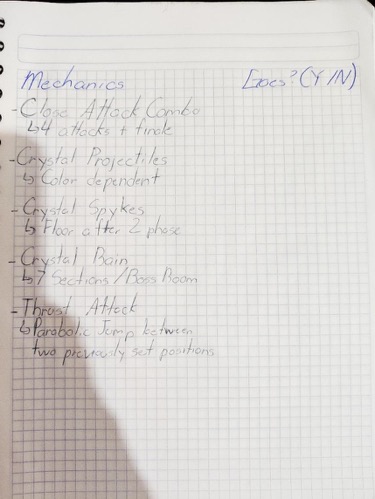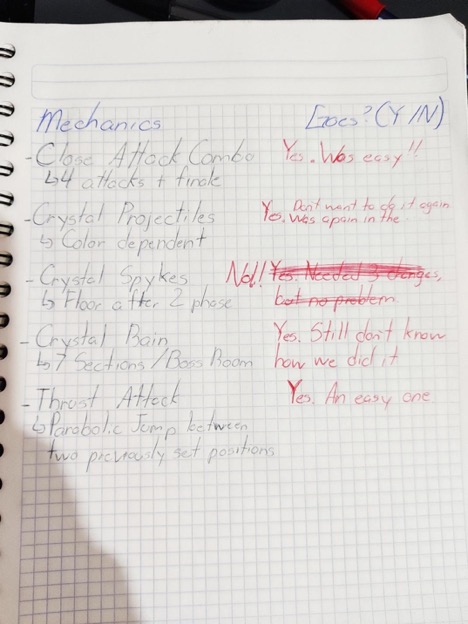Boss design by César Canto (programmer)
Boss Design (Alpha Version)
We are creating our alpha version of the Final Boss of Kisin, and wanted to share with you some insights about it, and let you know how we did it.
First you need to brainstorm what mechanics, abilities or things the player must have to do to beat the Boss and you want to be implemented, can be from previous experiences in the game or completely new, doesn’t matter for now.

Once you have a good enough list, choose which abilities seems the most interesting combined together.
Then, the fun part begins! Create those mechanics individually to be sure that they are as you thought they might be. It has happened to us several times, that we have thought of a marvelous idea and when finally is created in software and tested, didn’t seem so marvelous as we have thought. So, for that, is crucial to test all those you have chosen first. (Can have a couple of bugs, it's ok, if the main experience can be felt with that, is enough. Now we want to make sure that the experience is what we thought first).

If a mechanic didn’t fit in your design of the experience of the Boss fight, is a good idea to go back to your possible mechanics list and take another one, then repeat the previous step.
Or, you can just tune it until you get the feeling you were expecting from it. One case that happened to us was the movement of our Crystal Projectiles. Since was a rotational movement with a translational movement depending in time. We needed to adjust it like four times until we finally reached the movement we wanted.
And here is how it looks in Script. It might not be the cleanest, but it does the work perfectly, haha.
(I thought that once outside school, I wouldn’t need to use Trigonometry ever again...)
After all mechanics chosen were tested, and they resulted as you expected , then put all those abilities together and tune them together. This part can be broadly subjective. Depends on the type of experience you want to give to the player. For us we normally use 3-4 mechanics for each Boss, and we normally choose two mechanics that are simple and easy to master, one mechanic that is intermediate, and one that is hard to master.
Once they are put all together and work fine, without failing in giving the experience we design, then we do a final tune to the Boss. Using the Interest curve, we divide our Boss in three phases (almost all games use this structure), and divide those phases in three.
Learning Phase (The easiest one. Its main objective is to let the player learn what the Boss can do). To present and catch the player’s attention for the first time.
Then the Intermediate phase (The middle one. Where its purpose is to show the fourth mechanic or put the difficult level a little higher, but still you are learning here)
Then the Challenge Phase (The hardest one. Here is where all the abilities and mechanics of the Boss are to the highest level to give the player the final challenge. This can be achieved by expanding the damage area of the attacks and the speed of the abilities.
You can say that the phases can be put inside the curve as a representation of each part of it.
What we used in this part is the frequency of the attacks. After passing to each phase, the more challenging mechanics of the boss are shown more often than the simplest ones.
These steps have worked for us at the moment of developing Bosses for our game, and we believe we can create great experiences this way.
We are still young in this industry, so there will be much more fun and interesting experiences coming from us!
What do you think of our work process? Don't forget to leave your thoughts in the comments. Remember that your support give us strength to keep working.
Don't forget to FOLLOW US in Facebook: https://www.facebook.com/KisinMx/ and Twitter: https://twitter.com/kisinmx
And SUSCRIBE to our YouTube channel for more updates.
Get KISIN
KISIN
Fast Phase combat combined with color pattern attacks!
| Status | Released |
| Author | CalyStudios |
| Genre | Action, Adventure, Platformer |
| Tags | 2D, Difficult, Fast-Paced, Short, Singleplayer, Unity |
| Languages | English |
More posts
- Kisin is out for free!May 19, 2020
- Second level enemiesApr 21, 2020
- First level enemiesApr 14, 2020
- Kisin Game BalanceApr 07, 2020
- Play the new build of Kisin!Mar 19, 2020
- Zyana Spine AnimationMar 03, 2020
- First level gameplayFeb 25, 2020
- Main Menu + MusicFeb 18, 2020
- Kisin on itch.ioFeb 11, 2020
- Camera Transitions by César Canto (Programmer)Feb 04, 2020

Leave a comment
Log in with itch.io to leave a comment.